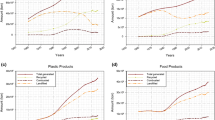Abstract
In a complex logistic environment it is critical to have efficient methods and tools to evaluate and improve the its efficiency. These tools must support the analysis with accurate results, but they must also be fast and easy enough to be used use in a complex practical setting. In this paper we present and discuss a deterministic single-period single-sourcing LP/MIP based method that the Linde Group has used for more than 100 projects for optimising the logistic network in the air-gas cylinder business. The model, called CSS (cylinder supply structure), includes a multi-echelon logistic network with transportation between plants and warehouses and distribution to several end-customers. The model allows deliveries to customers from all echelons in the supply network. Both the downstream flow of full cylinders and the upstream return of empty cylinders are included in the model. In general, more than 75 % of the total transportation- and distribution costs are caused by the final distribution to customers in a supply network as above. This paper will in particular analyse the distribution part of this model; how it is designed and how the cost is estimated. In order to evaluate the accuracy of the method we use empirical data to compare the model results with empirical results. The results showed that from the beginning the model overestimated the expected distances and costs for the distribution. With a rework and improved method to estimate the distribution cost, the model significantly improved its accuracy.











Similar content being viewed by others
Notes
In order to have a standard unit it is common to use the distribution cylinder equivalent (DCE). The DCE is equivalent to the footprint of a 50 L cylinder, 12 of those can be put in a pallet. If for another cylinder type it is possible to place 24 cylinders in the pallet, then the corresponding DCE would be 0.5.
References
Applegate DL, Bixby RE, Chevátal V, Cook WJ (2006) The travelling salesman problem, a computational study. Princeton University Press, New Jersey
Beardwood J, Halton JH, Hammersley JM (1959) The shortest path through many points. Math Proc Cambridge Philos Soc 55:299–328
Clark PJ, Evans FC (1954) Distance to nearest neighbour as a measure of spatial relationships in populations. Ecology 35:445–453
Cordeau J-F, Pasin F, Solomon M (2006) An integrated model for logistic network design. Ann Oper Res 144:59–82
Daganzo CF (1984a) The length of tours in zones of different shapes. Transp Res B Methodol 18:331–350
Daganzo CF (1984b) The distance travelled to visit N points with a maximum number of C stops per vehicle: an analytical model and an application. Transp Sci 18:331–350
Dantzig G, Fulkerson R, Johnson S (1954) Solution of a large-scale traveling-salesman problem. J Oper Res Soc Am 2:393–410
Elson DG (1972) Site location via mixed integer programming. Oper Res Q 23:31–43
Geoffrion AM, Graves GW (1974) Multicommodity distribution system design by benders decomposition. Manage Sci 20:822–844
Guedes AP (1994) An integrated approach to logistic strategy planning using visual interactive modelling and decision support. Ph.D. thesis, Cranfield University
Hertz P (1909) Über den geigenseitingen durchschnittlichen Abstand von Punkten, die mit bekannter mitteler Dichte im Raume angeordnet sind. Mat Ann 67:387–398
Higgins JC (1972) On the merits of simple models in distribution planning. Int J Phys Distrib Logist Manag 2:144–148
Mahalanobis PC (1940) A sample survey of the acreage under jute in Bengal. Sankhya Indian J Stat 4:511–530
Pirkul H, Jayaraman V (1996) Production, transportation, and distribution planning in a multi-commodity tri-echelon system. Transp Sci 30:291–302
Tsiakis P, Papageorgiou LG (2008) Optimal production allocation and distribution supply chain networks. Int J Prod Econ 111:468–483
Acknowledgments
The author wants to give special thanks to Professor Sven Axsäter for very valuable support during the work with this paper.
Author information
Authors and Affiliations
Corresponding author
Rights and permissions
About this article
Cite this article
Samuelsson, B. Estimating distribution costs in a supply chain network optimisation tool, a case study. Oper Res Int J 16, 469–499 (2016). https://doi.org/10.1007/s12351-015-0209-6
Received:
Revised:
Accepted:
Published:
Issue Date:
DOI: https://doi.org/10.1007/s12351-015-0209-6




